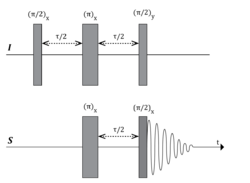Physics:Pulse sequence
From HandWiki

Timing diagram for an MRI spin echo pulse sequence.

An INEPT NMR pulse sequence for a heteronuclear experiment. The thin bar denotes a 90° pulse, while the thick bar denotes a 180° pulse. INEPT is a common building block of NMR experiments to improve 15N signal.[1]
In Fourier transform NMR spectroscopy and imaging, a pulse sequence describes a series of radio frequency pulses applied to the sample, such that the free induction decay is related to the characteristic frequencies of the desired signals. After applying a Fourier transform, the signal can be represented in the frequency domain as the NMR spectrum. In magnetic resonance imaging, additional gradient pulses are applied by switching magnetic fields that exhibit a space-dependent gradient which can be used to reconstruct spatially resolved images after applying Fourier transforms.[2]
The outcome of pulse sequences is often analyzed using the product operator formalism.
See also
References
- ↑ M H Levitt (2008). Spin Dynamics. John Wiley & Sons Ltd. ISBN 978-0470511176.
- ↑ Bernstein, M.A.; King, K.E.; Zhou, X.J.; Fong, W. (2004). Handbook of MRI Pulse Sequences. http://www.science-direct.com/science/book/9780120928613. Retrieved 2008-04-08.
External links
- Pulse sequences in the online textbook
- The Basics of NMR (by Joseph Hornak)
 |


